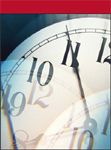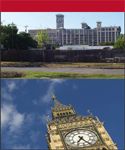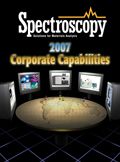The Original Scientific Instrument
After due consideration in his copious free time, columnist David Ball comes to the conclusion that the world's original scientific instrument was the clock. This might provoke a question: What does it have to do with spectroscopy? The answer might surprise readers.

After due consideration in my copious free time, I have reached the conclusion that the world's original scientific instrument was the clock.

David W. Ball
Yes, I know that people have used mirrors since antiquity, and humanity used their eyes to study the world around them (and used their brains to process the information they collected). I know that simple double-pan balances were used to measure masses of various materials. But balances were used as instruments of commerce, while mirrors were used for purposes ranging from vanity to warfare (for example, Archimedes' apocryphal use of a giant mirror or mirrors to set Roman warships ablaze during an invasion of Syracuse, Sicily, in about 214 B.C.). Eyes are natural, not constructed. No, the clock and its predecessors (like the sundial) were probably the first instruments constructed by mankind for the sole purpose of measuring a fundamental scientific quantity: time.
Time
What is time? We all know what it is, but actually defining it can be tricky. The Merriam-Webster online dictionary defines it as "the measured or measurable period during which an action, process, or condition exists or continues" and "a nonspatial continuum that is measured in terms of events which succeed one another from past through present to future" (1). Some have argued from the perspective of the second law of thermodynamics that time is the increasing of the entropy of the universe.

Doubtless one of the first recognitions of the passing of time was the day. The repetitious passing of the sun overhead on a regular basis supplied a marker of passing time. In temperate climates, the regular changing of the seasons provided another marker of passing time that eventually became realized as the year.
The ancient Egyptians usually are credited with the concept of dividing night and day into 12 periods each, called hours. Several reasons have been suggested for using the number 12, including astronomical reasons, the fact that the human hand has 12 phalanges (finger bones — there are three phalanges in each of the four fingers), or the idea that 12 is evenly divisible by 1, 2, 3, 4, and 6. The Sumerians are credited with inventing the sexagesimal (based upon 60) numerical system that ultimately was used to describe the passage of time, in about 2000 B.C. At some point, the division of the day into 24 parts was combined with the partitioning into 60ths and 60ths, so we now adhere to the concepts that there are 60 seconds in a minute and 60 minutes in an hour.
Measuring Time: Clocks
A variety of physical devices have been used to measure the passage of time since recorded history began. A stick in the ground can be used as a sundial, and burning candles and hourglasses support processes that occur at a constant enough rate that they can be used to track durations. One of the earliest mechanisms to measure time (estimated to go back to about 3000 B.C.) was a clepsydra or water clock (Figure 1), in which a vessel either filled or emptied at some slow, regular rate. Although it was calibrated with a sundial, a clepsydra had the advantage of being usable at night. Good clepsydras were not surpassed in accuracy until the invention of the pendulum clock.

Figure 1: A clepsydra, or water clock. If properly calibrated, it could mark the passage of time so well that it was not surpassed in accuracy until the invention of the pendulum clock.
It was sometime in the late 13th or early 14th century when clocks appeared throughout Europe. This was likely due to the invention of the escapement, a mechanical device that regulated the release of energy that was used to drive the clock mechanism. One example is shown in Figure 2. Most early clocks were part of churches, and the ringing of bells as part of the clock mechanism (indeed, the word "clock" comes from the Latin word cloca, meaning "bell") signaled times for religious services or other rituals. Early clocks had no hands. They relied on the number of rings of the bell to signify the passage of time. But by the end of the 14th century, hour hands were beginning to appear, and by 1475, the minute hand could be seen on clocks as well. The first record of a clock with a second hand appeared in 1560, while the first portable pocket watch was invented by Peter Henlein in Bavaria in 1524.

Figure 2: The escapement is a mechanical device used to control the release of energy in such a way that makes clocks possible.
Clocks not only were useful in indicating times for religious services. Science used them as well, most importantly in astronomy in order to accurately time the appearances of stars, planets, and moons. The spring-driven clock appeared in the 15th century, and astronomers Tycho Brahe and Johannes Kepler both benefited from the increased precision and accuracy of these new instruments. In 1657, Christiaan Huygens invented the pendulum clock, which was the next big step forward in clock technology.
Another activity that benefited from improved clock technology was navigation on the oceans. In the days before the global positioning system (GPS), a navigator could determine a ship's position by measuring the angle of a celestial object — the sun or some other notable star like the North Star — and knowing exactly what time it was. Recognizing the need for precision in navigation, in 1714, the British Parliament commissioned the Longitude Prize, a £20,000 prize for a method to accurately determine one's longitude at sea. British clockmaker John Harrison recognized that an accurate clock could be used, and he set about making one. Starting in 1730, over a period of 30 years, he finally developed a spring-driven clock that was accurate to within 10 seconds a day. (Politics, unfortunately, conspired to keep the prize money away from Harrison until 1773, when King George III personally intervened on Harrison's behalf. Harrison died three years later, at age 83.)
Finally, the Industrial Revolution gave clocks new meaning in several ways. First, it became possible to mass-produce parts so that clocks could be assembled in large numbers, driving their prices down and allowing ordinary people to own them. Second, with increasing employment in industry, employers needed accurate timepieces so they could properly compute hourly wages for their workers.
Today's Clocks
Modern clocks have a wide range of energy sources: pendulums, springs, batteries, or other electric sources. They come in analog — with hands — and digital forms. Modern clocks vary in size from a small wristwatch (introduced by Antoni Patek and Adrien Phillipe in 1868) to the 7-m–wide behemoth on the Clock Tower on the Palace of Westminster in London. (The clock itself is not called Big Ben; this is actually the nickname for the largest bell in the tower. While the Westminster Clock Tower is the largest chiming clock in the world, the largest four-faced clock is the Allen-Bradley Clock Tower in Milwaukee, Wisconsin, whose octagonal, 10-m–wide faces light up and can be used as a navigation landmark by ships on Lake Michigan. See Figure 3 for a comparison of these two buildings.) The concept of time is now recognized as a fundamental issue in the natural world, and the measurement and expression of time are crucial to systems like the aforementioned GPS as well as the Internet itself.

Figure 3: Two famous large clocks. Top: The Allen-Bradley Clock Tower in Milwaukee, Wisconsin, has the largest clock faces for a four-sided clock. Bottom: The Clock Tower on the northeast end of the Houses of Parliament building in London is one of the most famous in the world, and the largest chiming four-faced clock.
Science recognizes time as one of the seven fundamental units of nature, and we see time and the need to measure it as an important part of spectroscopy. For instance, the unit of frequency is 1/time, with the unit expressed written as s-1 or Hz (hertz). The exact measurement of time is a necessary component of many scientific experiments.
Why, however, is there an article on clocks in a magazine devoted to spectroscopy? I thought you'd never ask! It turns out that the world's most accurate clocks are atomic clocks, which are based on — wait for it — a spectroscopic transition of cesium atoms. So it turns out that spectroscopy has an intimate relationship in defining time. In the next rendition of this column, we will explore how spectroscopy is used to define time (2).
David W. Ball is a professor of chemistry at Cleveland State University in Ohio. Many of his "Baseline" columns have been reprinted in book form by SPIE Press as The Basics of Spectroscopy, available through the SPIE Web Bookstore at www.spie.org. His most recent book, Field Guide to Spectroscopy (published in May 2006), is available from SPIE Press. He can be reached at d.ball@csuohio.edu his website is academic.csuohio.edu/ball
References
(1) The Merriam-Webster online dictionary. Available at http://www.m-w.com/. Accessed August 21, 2006.
(2) The following Wikipedia entries were very useful in researching this column: time, clocks, second, minute, hour, escapement. Available at http://en.wikipedia.org
LIBS Illuminates the Hidden Health Risks of Indoor Welding and Soldering
April 23rd 2025A new dual-spectroscopy approach reveals real-time pollution threats in indoor workspaces. Chinese researchers have pioneered the use of laser-induced breakdown spectroscopy (LIBS) and aerosol mass spectrometry to uncover and monitor harmful heavy metal and dust emissions from soldering and welding in real-time. These complementary tools offer a fast, accurate means to evaluate air quality threats in industrial and indoor environments—where people spend most of their time.
NIR Spectroscopy Explored as Sustainable Approach to Detecting Bovine Mastitis
April 23rd 2025A new study published in Applied Food Research demonstrates that near-infrared spectroscopy (NIRS) can effectively detect subclinical bovine mastitis in milk, offering a fast, non-invasive method to guide targeted antibiotic treatment and support sustainable dairy practices.
